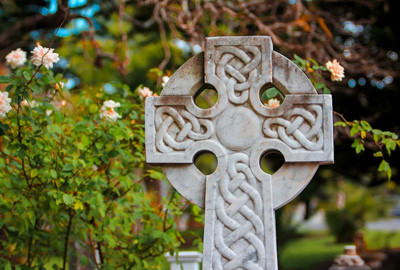In a recent interview the Archbishop of Dublin, Diarmuid Martin, speaking about a crisis of faith in Ireland, said, “For many, faith no longer plays a major role in their lives. Believers often view the reality of faith through a secularized lens of modern media.” Traces of God have been blurred by the endless noise and bustle of modern life and excessive rationalism. The tangible presence of God doesn’t even seem to be present in our most sacred liturgies. We have moved very far from the disciples’ experience of Scripture when they said to one another, “Were not our hearts burning within us on the road, while he (Jesus) was opening the Scriptures for us?” (Luke 24:32).
A plethora of books on various kinds of spirituality under the heading of Mind Body & Spirit have appeared in our bookshops to fill the void. Alongside books on Buddhism, Angels, and Mindfulness, books on Celtic Spirituality have become very popular. In fact, Celtic Spirituality has become a whole industry. Some of these books can be very tacky and Liam Tracey OSM, says that they appeal to people who want a spirituality without belonging to a church. “Celtic spirituality is presented in a very generic way but differentiated from Christianity especially in its Roman manifestations! So, it is inclusive, earth-centered and therefore good; Christianity is exclusive, dualistic and therefore bad.” (Celtic Spirituality: Just what does it mean?).
The Celtic Christian spirituality which emerged in the wake of St. Patrick seemed to be a blend of new and old traditions, Druidism enriched and enlightened by Christianity. “From it’s inception Celtic spirituality was based on the mystical experience of God’s love in nature and elsewhere” (Fr. Sean O’Laoire, The Leaven and the Diaspora). For the Celts there was no distinction between the material and the spiritual world. Places where people were most connected to God were called ‘Thin Places’, i.e. holy wells, lakes, woods and many other sites scattered around the country. The monasteries were often built on or near these sites. The Celtic designs of interweaving patterns in the manuscripts and in the early High Crosses were a way of showing that all things are interrelated and that all things are holy.
Mary, the mother of Jesus, was accepted for veneration quite easily. In the words of Fr. Sean O’Laoire, “she was the quintessential goddess, the female face of the Divine, the archetype, par excellence, of Mother Nature.”
St. Patrick’s prayerful style of life greatly influenced the people. Vocations to the monastic life flourished shortly after his time. The Irish Celtic Crossmonasteries became centers of learning and spirituality with a great love for the scriptures. The monastic life was ascetic, contemplative, missionary and very much in touch with nature. The monastic rather than the diocesan model of church became the norm until the 12th century. The Abbot and the Abbess often taking the place of the bishop. This seemed to be very much the position of St. Brigid of Kildare.
Prayer was central to the lives of all the people. They had blessings and prayers for all activities. St. Patrick’s Breastplate, attributed to St. Patrick, written much later but based on his writings, gives us an image of Christianity that was Christ-centered, Trinitarian and in tune with nature. The prayers of the Celtic saints are filled with the experience of God’s presence in creation. St. Columba said: “If you want to know God, first get to know his creation.”
Today science teaches us that we live in a web of relationships and connectedness. We are inter-dependent and interconnected to everything. In our New Story of the Universe we see God radically interior to everything. Our ancestors knew this by their spiritual intuition. They realized that all creation is permeated by the Divine Presence. Trevor Miller tells us that “The Celts had an awareness of the unity of Creation. They were aware of the Cross over Creation – that God was to redeem the whole created order. This was seen by the quiet care of all living things and a special affinity with animals that preceded Francis of Assisi”. (Celtic Spirituality: A Beginners Guide). Today we need to recover the sense of the sacred which so much influenced the lives of our ancestors.
Rose Sullivan
Holy Family Lay Associate

